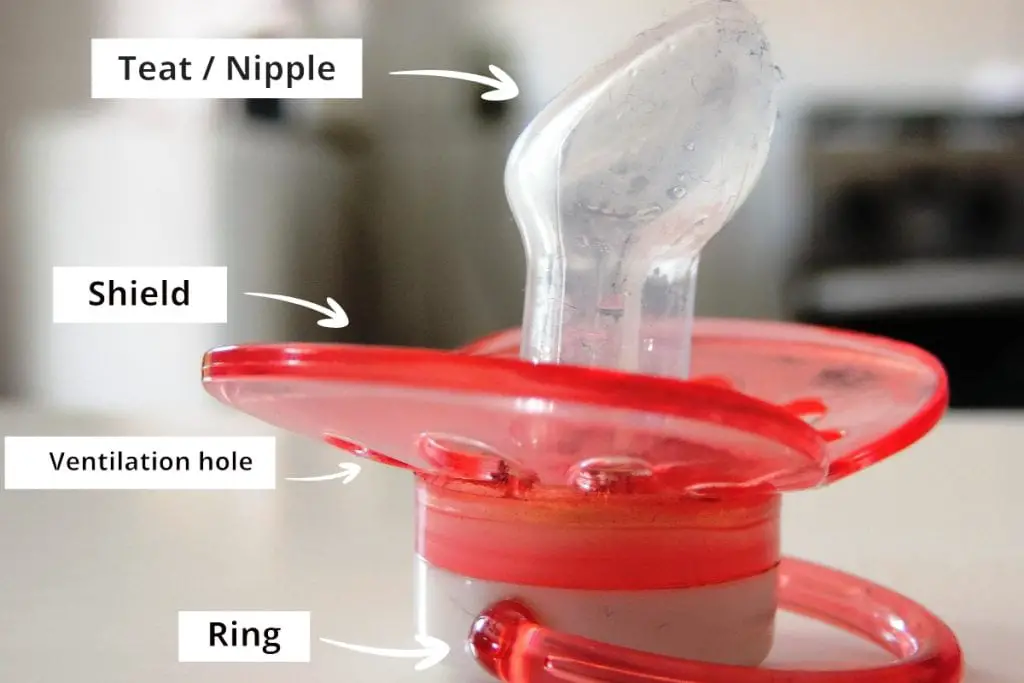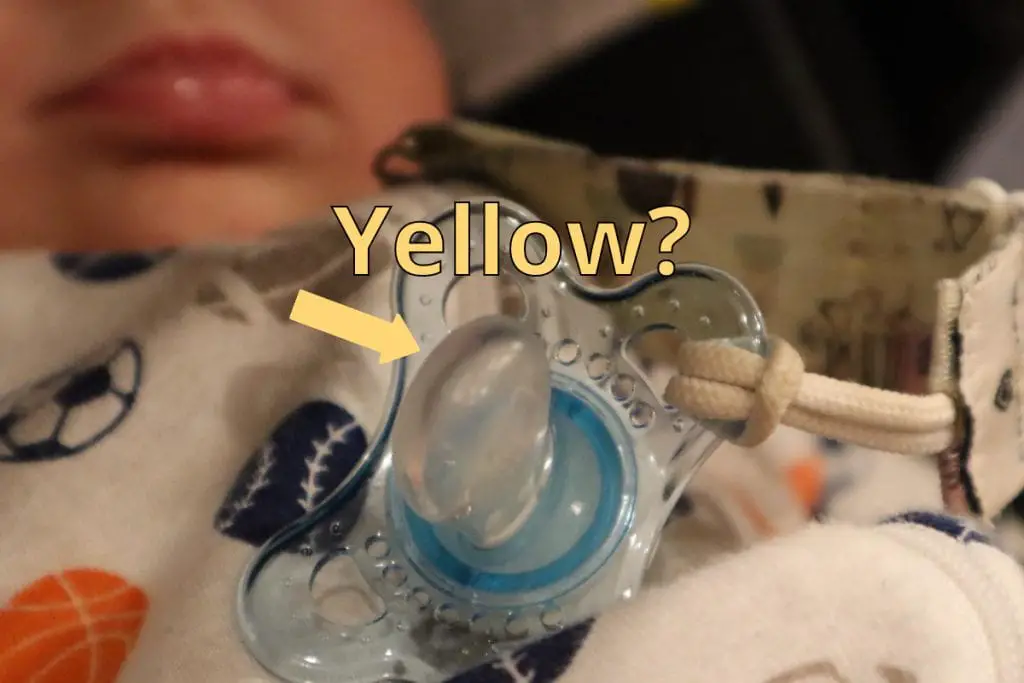You know how helpful it can be to have a pacifier on hand for your newborn baby. Or even for a toddler. It helps soothe a crying baby, and calm a parent’s nerves. But the rubbery section turns yellow after a while. Just why do pacifiers turn yellow? Does that concern you? Are you concerned that your baby could catch some disease from it? Or do you wonder if it will disintegrate? Here’s the (short) answer below.
The answer below includes sections on how pacifiers turn yellow when they are boiled or when they’re put in the dishwasher. It may also be because they age. The answer will include paragraphs on which dummy yellows more easily, and how to ensure a healthy pacifier.
All you Need to Know About Pacifiers

Here’s an image showing you how a pacifier is made up. The teat of the pacifier is called the nipple, even though it has more or less the same shape as the teat of a bottle. This is the term I’ll be using throughout this article.
Furthermore, any pacifier is made up of the nipple, the handle, and the mouth shield. The mouth shield is the part that fits over the mouth and cheek. It’s deliberately large so that the baby cannot swallow the dummy. The handle is simply the part whereby you put the dummy into the mouth and take it out again.
The entire object can also be called a dummy, not just a pacifier.
How do Pacifiers Work?
Pacifiers work by encouraging suckling. The suckling feeling brings comfort to your little one, and this is what soothes them when they are fussing. Studies show that pacifiers can reduce the crying time of infants.
However, you’ll always worry about color changes and hygiene, so the rest of this article addresses that.
Different types of pacifiers and which one is more susceptible to discoloration
You have three types of nipples for pacifiers: BPA, silicone and latex or rubber. Most people no longer use latex nipples, because a number of babies are allergic to them. What’s more, latex nipples are susceptible to heat and will wear with high temperatures. The plus side, on the other hand, is that they’re more natural than silicone, plastic, or BPA.
The latex nipples are also prone to yellowing and the reason for this is the same as why latex gloves turn yellow. There is a chemical reaction when latex is exposed to saliva which makes it turn yellow.
So, you can use silicone or BPA nipples. Both of the latter are less susceptible to yellowing, so if you want the dummy to last a little more, select one of the latter.
However, yellowing is a natural process of the dummy’s aging, so it’s to be expected. The time to replace it is when the nipple gets darker and larger or if there are pores or tears in the nipple.
When should you (regularly) replace a pacifier?
Knowing when to replace your pacifier is important because pacifiers degrade, discolor, and can harbor germs after a while. Manufacturers such as Philips recommend replacing the dummy every 4 weeks. Although others mention replacement only every 8 weeks, it might be better to be safe than sorry, and change the dummy more often.
All you need do is read the manufacturer’s manual that comes with the dummy.
Now, a note on the number of dummies you need at one time:
- You need a number of dummies at a time because the baby can’t just use one per day.
- Therefore, it’s best to buy them at the same time, so you know exactly how long you’ve used them.
Remember that if the dummy nipple becomes darker and larger, it’s time to replace it. It’s also time to replace it when it starts looking porous because you don’t want your child swallowing any plastic or silicone particles.
Cleaning a Pacifier
I recommend several methods for cleaning a nipple:
- Rinse the pacifier in hot water and dish soap.
- Wash it in a solution of 50% white vinegar and 50% water.
- Mix sterilizing solution with water. Soak for 5 minutes, no longer.
- When you first get the nipple, you could also boil it for a maximum of 5 minutes, but don’t boil it ever again. Both latex and silicone nipples won’t endure that amount of heat for that length of time.
- There is another option: place the dummy in a sterilizing case, and sterilize it in the microwave.
It shouldn’t turn yellow if you use any of the methods listed above. However, if you put it in the dishwasher, it’ll turn yellow.
Then, to prevent the dummy from getting dirty after washing, you could put it in a storage case. I discuss this in my article on some great pacifier cases.
Water in the Nipple
Once you’ve washed your pacifier, you may find that you get water in the nipple. This is because of the air channel built into the nipple–water may enter there during cleaning. You need to take the following steps to clean it out:
- After sterilizing the pacifier, shake off the liquid whilst holding the handle.
- Wash your hands and dry them on a paper towel.
- Squeeze the nipple toward the mouth shield of the dummy.
- The excess water should drain out.
How to clean a pacifier that turned yellow
If a pacifier has turned yellow, there’s nothing much you can do to make the color change back again. Inspect it for cracks and tears, but if there are none, then use it as normal. Clean the pacifier as you would any other dummy. Sterilize it or run it under hot water.
Here’s a YouTube video on how to clean and sterilize your pacifier:
Can my baby get sick when the pacifier is yellow?
Your baby can still use a pacifier with a nipple that has turned yellow. There are no more germs on it than on a normal dummy. It won’t make your baby sick. Again, just make sure it’s not beyond its expiry date and that you clean the dummy regularly. Some parents have more than one pacifier in case they need to clean one or throw one away.
Conclusion
Pacifiers are useful for both parents and babies in bringing a calm and relaxing atmosphere to the home. This is the main reason parents buy them after all. In fact, you and your kids often give pacifiers pet names to express their value.
The main concern is keeping dummies hygienic. The question of why pacifiers turn yellow is about that but is actually unrelated. Your child’s dummy is safe when yellow. Just clean it regularly.
